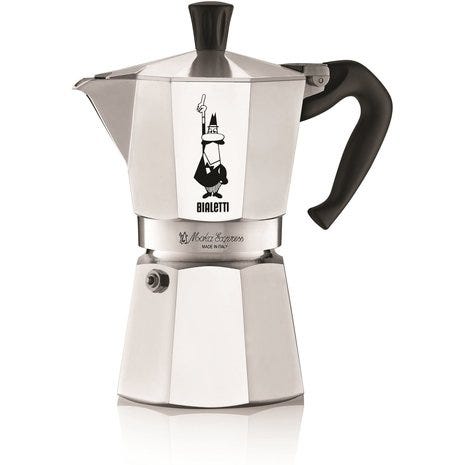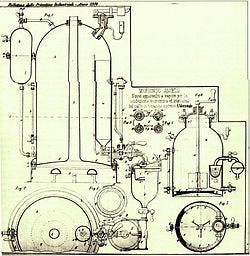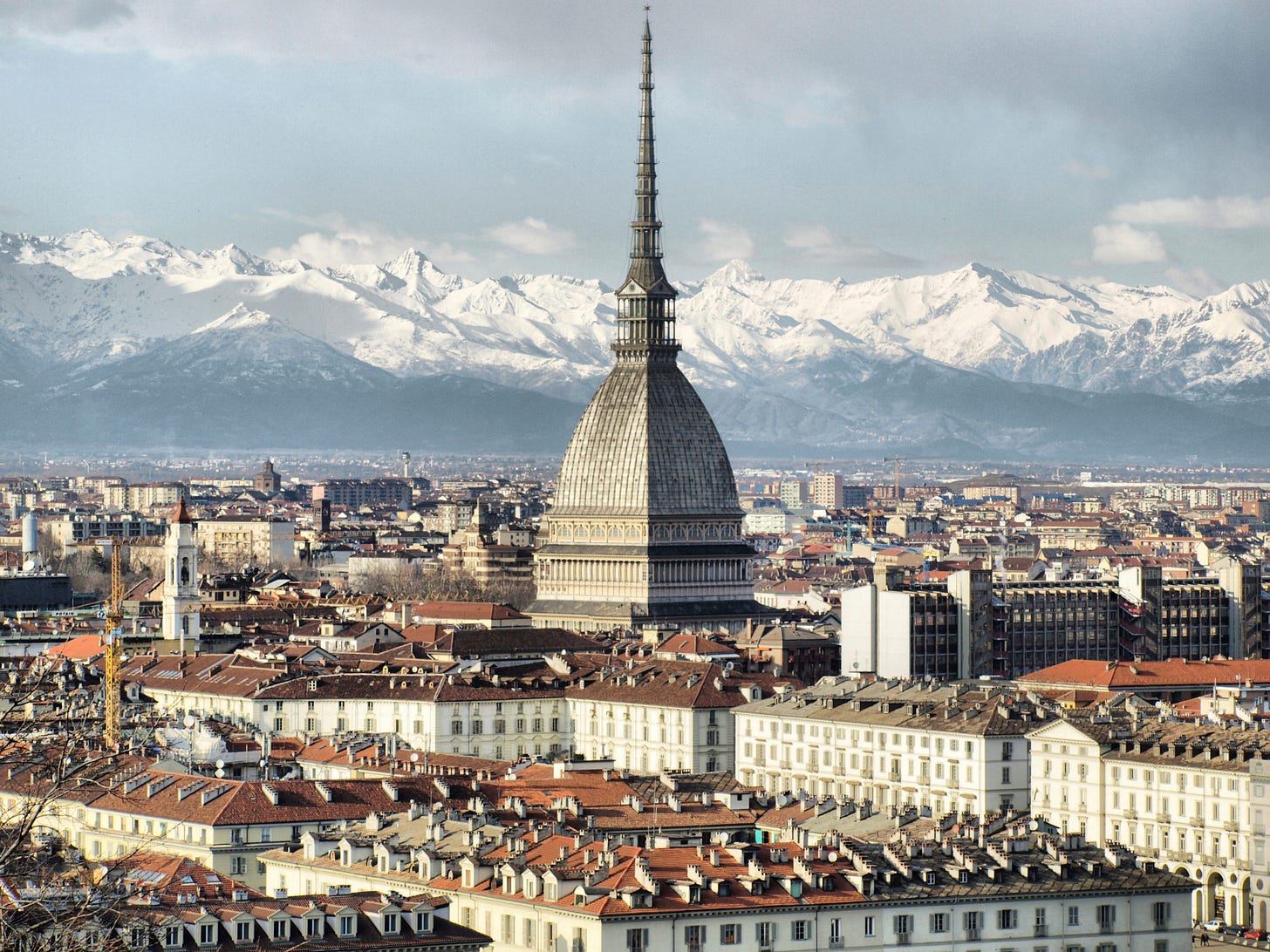I regularly post technical content, so I feel like my dear intelligent readers deserve a coffee break to rejuvenate their brain cells. And not just any coffee break, an Italian one. As an Italian, I grew up surrounded by coffee rituals, and I can tell you that Italy gave the world not just great coffee, but ingenious ways of brewing it, each with its own history, mechanics, and flavor.
In this post, we will explore three classics that define our culture: the Moka pot, the Espresso machine, and the Napoletana, and finally crown the Cappuccino. Along the way, we will also bust some common myths about Italian coffee, including the biggest one of all.
1. The Moka Pot: The Everyday Icon
History:
Invented in 1933 by Alfonso Bialetti from Torino, the Moka pot became the sound of Italian mornings. Its aluminum body and iconic design made it a kitchen essential, especially in postwar Italy.
How it Works:
It has three chambers: water at the bottom, coffee in the middle, and brewed coffee at the top. Steam pressure (around 1–2 bars) pushes boiling water through the grounds into the top chamber.
Taste:
The Moka brews strong, bold coffee - more concentrated than drip but gentler than espresso. Expect a sturdy, homely cup with a touch of bitterness.
Pros & Cons:
✅ Affordable, simple, and iconic; ideal for everyday home brewing.
✅ Produces a strong, satisfying cup without needing an expensive machine.
❌ The boiling pressure can sometimes push fine grounds upward, leaving “ash” or residual particles in the cup.
❌ Can over-extract easily if left too long on the heat, leading to bitterness.
☕ Myth vs. Reality:
Myth: “Moka coffee is basically espresso at home.”
Reality: Moka uses only 1–2 bars of pressure, while espresso uses 9. The result is strong and bold, but not nearly as concentrated or creamy as true espresso.
2. Espresso: Italy’s Cultural Export
History:
The first espresso machine was patented in Turin in 1884, but it was Achille Gaggia’s postwar design that gave us the high-pressure espresso we know today - crema and all. From there, espresso bars became the beating heart of Italian cities and now all over the world.
First patent (vol. 33 n. 256, 1884) for the espresso machine, by Angelo Moriondo
How it Works:
Espresso machines force hot water through finely ground coffee at about 9 bars of pressure, producing a concentrated shot in under 30 seconds.
Taste:
Espresso is intense, thick, and complex, with layers of bitterness, sweetness, and acidity. It’s the foundation of cappuccino, macchiato, and countless other café staples.
Pros & Cons:
✅ Produces the richest, most complex flavor, complete with crema.
✅ Versatile: the base for lattes, cappuccinos, and more.
❌ Requires expensive equipment and some skill to get right.
❌ Not very forgiving: grind size, tamping, and water temperature must be precise.
☕ Myth vs. Reality:
Myth: “Espresso is meant to be sipped slowly like filter coffee.”
Reality: In Italy, espresso is usually enjoyed quickly, often standing at the bar. It’s a short, intense ritual, not a long drink.
3. The Napoletana: The Slow Ritual
History:
The Napoletana or cuccumella, originated in Naples in the early 19th century, inspired by French drip coffee pots. Over time it became a symbol of Neapolitan culture, where preparing coffee is as much a ritual as it is a pleasure. The pot comes in many shapes and sizes, from charmingly small versions for a single cup to large ones designed to serve a big family.
How it Works:
The Napoletana is a bit of a puzzle at first, and that’s part of its charm. The pot is made of two chambers that fit together, with the coffee in the middle. You start by filling one side with water and heating it. When it begins to boil, comes the magic moment: you flip the whole pot upside down. The hot water then gently drips through the grounds by gravity, slowly filling the chamber below.
Most people can’t figure out how to use it without being shown the trick: it looks counterintuitive, even a little comical, the first time you try. But once you learn the flip, it becomes fun, almost theatrical. That little moment of confusion followed by mastery is exactly what makes the cuccumella more than just a coffee maker: it’s a ritual, a performance, and a story to tell at the table.
Taste:
The result is a cup closer in “length” to an Americano - lighter and more diluted than espresso, but smoother and more aromatic than what a Moka pot produces. It’s not meant to give you a quick jolt; it’s meant to be savored slowly, often after dinner, in long conversations.
Pros & Cons:
✅ Produces a clean, pure cup because the water drips gently through the grounds.
✅ No bitterness from pressure or overheating-soft, balanced flavor.
❌ Slower process that requires patience and attention.
❌ Less common today, harder to find outside Italy, and not suited for those who want a strong jolt.
☕ Myth vs. Reality:
Myth: “Italian coffee is always fast and strong.”
Reality: The Napoletana proves the opposite. It’s a slow, gravity-drip method that produces a gentler, longer coffee, more like an Americano in length than an espresso.
Why I Love It:
Of the three methods, the cuccumella is my personal favorite. Maybe it’s because of the little theatrical flip, or maybe it’s the way the coffee comes out so soft and clean, with none of the “ash” that a Moka sometimes leaves behind. But most of all, I love that it gives me a longer experience. An espresso shot is gone in a sip or two - it never lasts long enough for me - whereas a Napoletana cup invites you to linger, to sip slowly, to stretch out the moment. For me, it captures the spirit of coffee as a ritual: slow, playful, and shared.
👉 One tip: I recommend not grinding the coffee beans too fine. A coarser grind keeps the liquid beautifully clear and “ash-free,” which is part of the pleasure of this method.
And Finally Comes the King: Cappuccino
After talking about brewing methods, it would be unfair not to mention what, for me, is the ultimate Italian coffee experience: the cappuccino. This is my favorite latte-style drink: the king of breakfast tables across Italy.
History:
The cappuccino’s story starts not in Italy but in 18th-century Austria, where the Kapuziner was popular in Viennese cafés. It was black coffee mixed with milk until it reached the warm brown color of Capuchin monks’ robes, more like a modern caffelatte than today’s cappuccino, because it lacked the signature milk foam.
It was only in 20th-century Italy, with the spread of espresso machines equipped with steam wands, that the cappuccino evolved into its modern form: espresso, hot milk, and a cloud of silky foam in perfect balance. Italy didn’t invent it outright, but it perfected it and made it iconic.
How it Works:
A classic cappuccino is one-third espresso, one-third steamed milk, and one-third foam. The foam insulates the drink, keeping it warm, while giving every sip a light, creamy texture.
Taste:
The cappuccino balances intensity and comfort: strong espresso softened by the sweetness of milk, capped with airy foam. It’s richer and creamier than an Americano, but gentler than a straight espresso.
Why I Love It:
Among latte-style coffees, this is my favorite. The contrast of robust espresso with velvety milk feels like harmony in a cup. And unlike a quick espresso shot, a cappuccino lasts long enough to savor, though never quite as leisurely as a cuccumella. To me, it deserves its royal title: the king.
Pros & Cons:
✅ Comforting, balanced, indulgent, and iconic.
✅ Perfect breakfast drink, especially alongside a pastry.
❌ Needs an espresso machine and some barista skill.
☕ Myth vs. Reality:
Myth: “Italians only drink cappuccino in the morning.”
Reality: Italians raise eyebrows if you order it right after lunch, since milk is seen as heavy on a full stomach. But having a cappuccino in the afternoon, as a 3 PM pick-me-up or a cozy café break, is perfectly normal. In fact, that’s my favorite time to enjoy it.
And finally…The Biggest Myth of Them All
☕ Myth vs. Reality:
Myth: “Italians make the best coffee in the world.”
Reality: Italians didn’t invent coffee, but they did revolutionize how it’s prepared and enjoyed. They gave us the espresso machine, the moka pot, the cuccumella, the cappuccino ritual and, with companies like Lavazza, the very idea of blending beans from different origins to create a consistent flavor.
But the truth is, “Italian coffee” today often relies on dark, heavy roasting to mask lower-quality beans. While the technology and traditions were groundbreaking, the global spread of industrial Italian brands means you’re just as likely to get a bitter, over-roasted cup as something extraordinary. The real magic of Italian coffee isn’t always in the taste - it’s in the rituals, machines, and cultural theatre Italians built around it.
A Turin Story
Torino (Turin) is undeniably the birthplace of modern Italian coffee culture, and its legacy extends beyond the famous inventions.
Espresso Innovated: In 1884, Angelo Moriondo of Turin patented the world’s first espresso machine, introducing a machine that controlled steam and water separately to brew coffee efficiently.
Blending and Industrial Roasting: In 1895, Luigi Lavazza opened his Turin grocery. He pioneered the concept of blending beans from different regions and scaled it industrially, making consistent, balanced coffee available at home.
Everyday Coffee for Everyone: Just a few decades later, in 1933, Alfonso Bialetti from Piemonte (same region as Torino), invented the Moka pot, popularizing strong coffee for the masses across Italian homes.
But Turin’s coffee inventions don’t stop there:
Iconic Coffee Drinks from Turin:
The Bicerin, created in 1763 at Caffè Al Bicerin in Turin, is a layered drink of espresso (or moka), chocolate, and cream - still a Piedmont tradition.
Its modern cousin, the Marocchino, combines coffee, cocoa, and foamed milk in a small glass, born in Turin as a playful interpretation of the original.
Together, these inventions and cultural gems show that Turin not only invented coffee technologies but also transformed coffee into an art of drinking and social ritual.
If you loved this content, please subscribe or refer a friend!





